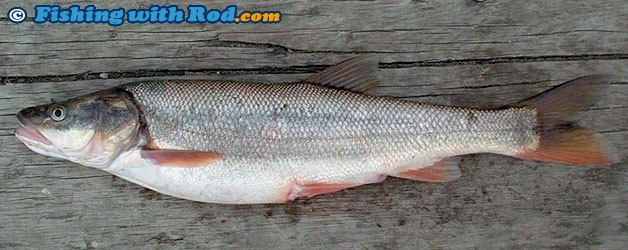Northern Pikeminnow
Ptychocheilus oregonensis

If you fish in British Columbia's rivers and lakes frequently for salmon and trout, then most likely you have encountered this species. Northern pikeminnow are not specifically targeted by BC anglers due to their poor eating quality. They are regarded as pests because they compete indirectly with salmon anglers by feeding on salmon fry and eggs. However, this native species has a fascinating life history and plays an important ecological role in watersheds of the Pacific Northwest. They can grow to a very large size, and their tremendous fighting power on light tackle can provide excellent sportfishing, especially for children.
Description
Northern pikeminnow have a dark green or green-brown back and a white/cream abdomen. Their head is relatively long, approximately 22% to 23% of the total length. The eyes of adults are small. Their tail is distinctly forked. The fins are clear, however males display yellow/orange lower fins during spawning periods. Mature individuals generally have a rounded belly. Average size ranges between 30cm to 50cm or two to four pounds. However fish up to 25 pounds have been recorded, and are generally found in large interior lakes where primary productivity is high.
Distribution
Northern pikeminnow can be found in British Columbia, parts of Washington and Oregon. They are present in most of the major BC river systems, including Fraser, Skeena and Columbia Rivers. Smaller fish or young adults are also found in smaller streams. Large individuals are usually found in the interior lakes. Although a freshwater species, northern pikeminnow can also be found in the estuary system as they get carried down by the spring freshet.
Life History
Spawning periods of northern pikeminnow occur between May and July. They generally spawn in shallow gravel riverbed, along the lake shore or river bank. The fish tend to gather in large numbers, and each female will spawn with more than one male. The eggs are released near the bottom, and will settle on the ground eventually. The eggs will hatch in a week. Sexual maturation is reached in six years when they are about a foot long. Their lifespan is quite long, up to 30 years.
Northern pikeminnow are generally scavengers, and their diet varies from small insects to large shiners. Young individuals (2cm - 10cm) will feed on insects until they grow larger. Fish that are in the middle size range will feed on plankton and small fish such as salmonoid fries and shiners. Large northern pikeminnows that live offshore will only feed on fish. During the salmon spawning season, they will also feed on eggs that are being deposited in redds.
Fishing Locations
When fishing for any species, it is important to know where to look for the fish. Northern pikeminnow usually inhabit shallow portions of large rivers. They can be found in the entire Fraser River system and tributaries. When fishing in the Fraser estuary, look for northern pikeminnow close to shore near structures such as rocks, logs, eel grass, pylons and piers. Due to the strong current in the main channel, they usually choose slow water where no current exists.
Fishing Techniques
Prime time to fish for northern pikeminnow is between the months of May and September. However, larger fish are usually caught between June and August. Fish that are caught before June are usually less than a foot long in the Lower Fraser River.
Northern pikeminnow can be great fun on light tackle, so it is ideal to keep the line under 6lb test. Your rod should be around 6 or 7 feet long, a small spinning reel with a nice drag is all you need. There are many ways to catch them, these techniques include spinning, float fishing, bottom fishing (bar fishing) and jigging. The easiest way is definitely float fishing. All you need is a light float with properly balanced weights, accompanied by some bait such as bread, worms, or roe. Drift the float near rocks, and strikes will usually occur within seconds if fish are present. This method is usually used in calm waters where no or little current exists. Bottom fishing can also be quite effective, but you risk the chance of loosing your tackle from snags. Again, a bar rig can be used with the above mentioned bait. You weight should be light, preferably below 1oz. Bottom fishing is used in waters where current is found. The key for both methods is to keep the bait close to the bottom, where the fish are.
Spinning is also another fun method because it's challenging. Spinning has the advantage of only hooking larger fish because the smaller fish will not attack a lure half of their size. Popular lures include spoons and inline spinners. Choose your lures based on the colour of the water and the light intensity. If it's cloudy and the water is dirty, I would go for a orange or darker lure. If it's sunny and the water is fairly clear, then a silver or bright lure is used. Location is also a major factor too. If baitfish are found where you are fishing such as the Fraser River mouth, then I would go for a silver lure. Make sure the size of the lure matches the size of the fish. When spinning, keep your lure as close to the bottom as possible. Be prepare to strike as the lure gets closer to shore because that's where the fish are. The only disadvantage with spinning is that it is too "fast" for the squawfish. Squawfish have a tendency to hesitate before they strike.
Jigging is also a popular method but again you risk the chance of snagging the bottom. Pink worms, orange worms, black worms are just some of the effective jigs. To avoid snagging, you can attach a running float to your line with a stopper on top. Like crappy fishing, this keeps the jig suspends just above the bottom and still allows you to jig as the float slides along the line.
